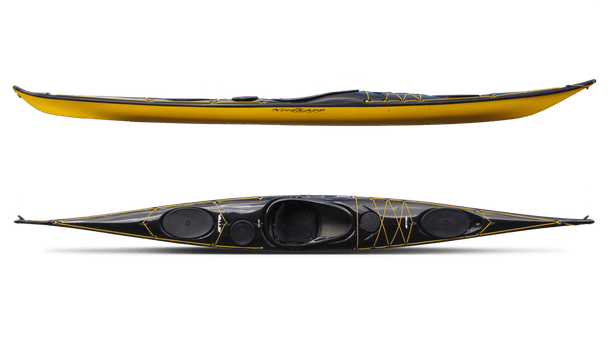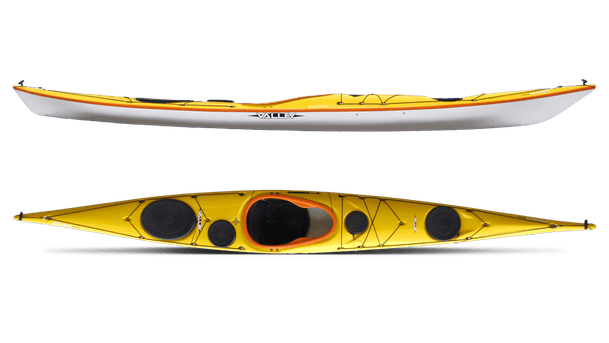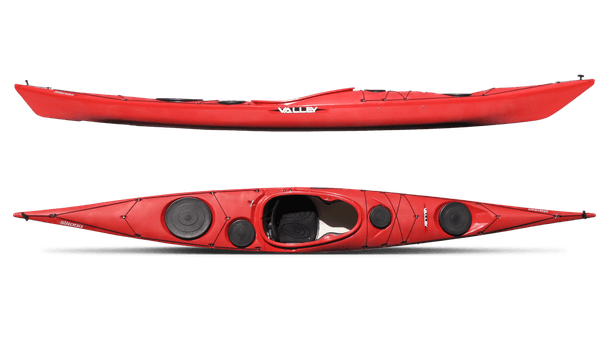- Home
- Gear & Reviews
- Nordkapp HS
Nordkapp HS

This Product Has Been Discontinued
More Kayaks from Valley Sea Kayaks:
Nordkapp HS Description
The Nordkapp HS is a kayak brought to you by Valley Sea Kayaks. Read Nordkapp HS reviews or submit your own review to share with the paddling community. Check out a few other kayak recommendations below or explore all kayaks to find the perfect one for you!
Valley Sea Kayaks
Nordkapp HS Reviews
Read reviews for the Nordkapp HS by Valley Sea Kayaks as submitted by your fellow paddlers. All of the reviews are created and written by paddlers like you, so be sure to submit your own review and be part of the community!
There is a lot of confusing…
Unfortunately, reader and potential buyer beware, even when a review is about Nordkapp HS, there are several different kayaks with this name in existence. I have no experience with the current "Nordkapp Classic" with 'HS' designation; however, based on some earlier reviews in this section, I strongly suspect that even the "Nordkapp Classic HS" handles quite differently from the original Nordkapp HS.
I have paddled my 1987 Nordkapp HS for the past 2 seasons. The way to recognize this older model and to differentiate it from the new "Classic HS" look for:
- round rather than oval stern hatch,
- absence of a day hatch,
- non-recessed cockpit coaming in the back,
- molded gelcoat rather than screw-in plastic recessed deck anchoring points,
- skeg control box in front of the cockpit rather than behind it, and
- skinny triangular plastic skeg. My HS has a thick long rectangular fiberglass skeg.
- the older HS also had a hand chimp pump behind the cockpit.
From what I understand, the hull shape of my 1987 Nordkapp HS is the same as the original Nordkapp but it has a skeg which the original lacked. I have seen HS applied to the original Nordkapp multiple places so, if you are looking to get one on-line, make sure it has a skeg at all. Look here (http://www.ukseakayakguidebook.co.uk/nordkapp/art_nordkapp.htm) for an excellent coverage of the confusing Nordkapp family tree.
I hope this will clear some of the confusion about the model. That being said, I had a chance to compare my HS to a 2000 American model with Jubilee on the deck and H2O on the manufacturer sticker. From what I understand, the original Jubilee had a round front hatch and '2O' in H2O stands for two oval hatches. Story goes that American distributors applied Jubilee stickers to boats that should have been designated as H2O. In other words, the comparison boat is most likely H2O.
These two Nordkapps are very different boats. It is not easy to see the difference when they are on the ground or in the water. However, once hoisted on top of the car, the differences in hull are quite apparent. The newer boat has longer waterline, less overhang on both the bow and the stern, and considerably more volume toward the ends of the boat. The bow on the new boat does not rise up quite as much as on the old Nordy. Front deck in front of the cockpit is a bit higher and aft deck is lower on the H2O. H2O has less rocker—especially at the stern.
What is very hard if not impossible to see, is that the hull shape under the cockpit is also different—H2O is a bit wider and has a more pronounced chine, while HS is skinnier and rounder.
Not surprisingly, HS and H2O paddle and quite differently. Stability wise, HS is has substantially lower primary and virtually no secondary. Taking pictures in the HS in anything but flat water is tenuous. HS is very easy to put on edge; however, there does not seem to be any point at which the boat starts to resist the capsizing momentum and locks in that edge—it will just keep on going and capsize if you let it. I agree with previous posters who claim that HS has no surprises in rough water. Surprises from the boat come when you expect that the boat will keep you up and it fails. With HS you are always in charge of staying upright—the boat will not keep you up. Some may consider this as a negative; however, consider this—when broached sideways on when current hits from the beam, there is no chine to grab onto and trip you over. Stability profile of the HS is neither good nor bad—it’s just unique. Some people will like it some wont; some conditions will reward it while others will punish.
At nearly 18' Nordkapp is considered a fast boat. Unfortunately, with all the overhang and extremely low volume at the ends the effective waterline of HS is noticeably is shorter than H2O. HS has more rocker which further reduces its cruising speed. It gets worse, in waves, paddling side-by-side HS tends to bury the bow when going down wave much quicker and more frequently than H2O which translates into further loss of cruising speed. In calm conditions, I can cruise at 4 knots all day in my HS, maintain racing speed of 5 knots for a marathon distance, and push the boat to a maximum speed of about 7 knots for a couple of seconds.
I have not noticed much difference in tracking and turning performance of these two boats. Nordkapps in general are quite bad in beam winds and require skeg. I would not recommend the original Nordy without the skeg for paddling in any wind. Manufacturers quickly noticed the problem and produced HM with a molded skeg. HM is a beast that requires a lot of edge and effort to be turned and sacrifices all the benefits of Nordkapp’s rocker for maneuverability. I much prefer the original hull design with an optional skeg. You would think that HS would be easier to turn and more vulnerable to windcocking than H2O and it may well be that way. The reason for this difference between HS and H2O being small is, perhaps, in the fact that H2O is more comfortable on the edge and, due to its higher volume around the cockpit, may lift the ends out of the water more effectively when on edge.
Ocean cockpit is a thing of the past, in my opinion. I am 6’ and under 180lbs and I used to have to wiggle quite a bit to get in. I added the recess to the back of the cockpit and lowered it by about an inch (see photo blog: http://picasaweb.google.com/Karovaldas/NordkappHSUpgradesJulyAugust2009#). Still, if I wear any boots, I need to wiggle to enter. Keyhole cockpits are much easier to enter and exit and, with modern materials for spray decks, they are just as watertight and reliable as the smaller and much less comfortable ocean cockpits. Ocean cockpit is a potential hazard when you need to get out of the boat fast. Capsizing is the only option. Re-entry repertoire is limited to re-enter-and-roll in all but the calmest conditions (unless you have a paddle float to stabilize yourself during a scramble). Efficient forward paddling is limited by the inability to bend the knees. Some people worry about getting stuck in the small cockpit after capsize. Fear not! Staying in is a much bigger problem :) I've been sucked clean out of the boat by waves as small as 4'.
It gets worse, the original HS cockpit is only 15" wide. For me this means that my edging ability is limited by the side of the cockpit hitting my ribcage on extreme edge. C2C and hand-rolling is similarly hampered by this lack of space around the hips. As far as rolling goes, the back of the cockpit is also too high for layback rolls. Even after I lowered it by 1", I still need to lift my butt of the seat for laybacks but I can now perform a hand roll. With narrowness limiting your ability to do C2C and high aft coaming interfering with laybacks, forward-finishing roll is your best option in this boat.
My HS did not have a day hatch or a third bulkhead behind the seat. It’s very convenient to have one for items you may need to access while on the water. Beyond comfort there’s a safety issue—since there is no bulkhead immediately behind the seat, in case of capsize the boat will take on an additional 5 gallons of water! Not helping is the fact that there is at least a foot of empty space between my footpegs (33" inseam) and the front bulkhead — that's another good 3 gallons of water and wasted gear storage space.
In place of the third hatch, Valley has installed an optional hand pump. Mine worked just fine even 20 years after the boat was manufactured. Unfortunately, its placement behind the seat made it quite useless in rough water. Balancing while pumping with my right hand behind my back is quite precarious in this tippy boat. It may be possible in the ocean where one has time between the waves; however, short wave periods of the Great Lakes' storms prevent it.
Skeg control box on my HS is behind the cockpit. Same issue as with the hand pump—in rough water, where you are more likely to need the skeg, balancing the boat becomes very interesting; especially if the skeg gets stuck. I have capsized once while trying to adjust the skeg and promptly moved the controls from the back to the front of the cockpit. The old-fashioned skeg is very nice, works well and does not vibrate at high speeds the way the skinny modern plastic skegs do; however, there is a price—the skeg box in the rear hatch is enormous and takes up quite a bit of storage space. Getting to the space behind the skeg box is difficult.
So there you have it, my honest assessment of the Nordkapp HS. It was my first real sea kayak and it was an excellent teacher. Before I knew better, I was an ardent advocate for this craft. My skills went up faster than they would have in a more stable boat, I am sure of that. The old HS is a great tripping boat with sufficient bracing recovery and balancing skills. It also gains substantial stability when fully loaded. You will need to pack everything in small dry bags to fit through the round 7.5" hatches but I don't really see that a drawback. HS is great training platform for rough water and behaves very well in it. It will teach you balance and self-reliance. It will amply reward skills and, when it does not, you will only have yourself to blame. It is considerably less stable than most other boats in this class as well as its younger Nordkapp brothers. HS is also slower and less convenient than the modern models. On the positive side, you can snatch one for under $1,000 on the used market which is hard to find for any other fiberglass kayak model. For that price, it’s a good deal as long as you realize what you are getting and are willing and able to put up with the requirements that this boat imposes. It's not the boat I would choose if finances were not an issue.
6"2, 170lbs, Intermediate…
I've heard terrible things about the HS have a very low initial stability and good secondary. I find this overstated, and to a point not true. Traces of tippiness fade as soon as you become familiar with the boat, usually a couple of hours. The boat edges predictably and can be leaned over with very positive results. All in all if your balance is good, and you are used to a narrow beam, you will love the HS. Primary stability is lowish (but suitable) and secondary is solid.
The boat has plenty of rocker for a 17+ footer, and when leaned it turns very quickly and smoothly. Once you drop the skeg (which I basically never use) the boat tracks as straight as any British form boat I've ever been in. With the skeg down you will need to really lean the HS to turn it over, but it can be done. I also notice a humming and vibration coming from the skeg box as the blade moves about in the enclosure. Not so much annoying, but does take away some serenity on a nice calm day.
The boat rolls like a barrel. I wish the back deck and cockpit coaming were a little lower, but you can get very low on the back deck all the same. After 30 minutes of straight rolling I've found my valley hatches (round, new, with steel snap ring around them) to be completely dry. I've actually never been in / around a boat that I can say this about.
The hatches are a bit small for packing but I put my bags inside, pack them and close them, and then locate them in the hatch. I believe that the smaller diameter hatches seal better and having less surface area exposed to the elements helps keep them dry.
Even the old chimp pump works well. Although I haven't had to do a re-entry into the boat (yet) I did fill the boat with water and try it out. The pump is slower than some new hand pumps, but it pulls water from behind the seat and pushes it out the port side behind the cockpit. The nicest thing about this is that after a rolling session, if I'm staying in the boat, I can pump the boat out without having to pull of my skirt. If you've never seen one of these please check them out online, they are very funny.
The reasons for the 9... Skeg noise, smallish hatches, no boat is perfect. I must say that looking at the old girl make me smile. I would put this boat up against any other brit form / greenland style boat built to modern spec. Absolutely the nicest all around boat I've ever paddled, does everything well.
For the past year I have…
Recently I also purchased a Nordkapp HS (hull standard). While my HS was made in 1994, it has the same hull shape as the original 1975 Nordkapp. There are a number of differences between the older HS and the current H2O versions of the Nordkapp, notably the HS has an ocean (round) cockpit, a lower front deck and a higher rear deck. These differences relate to what is above the waterline. While Valley says the hull shape (what's in the water) has changed with the H2O, I cannot see any difference when I do a side by side comparison of the HS and the H2O. As well, when I paddle the two kayaks I can detect no difference in their performance.
The HS is still available from Valley as the Nordkapp Classic, complete with ocean cockpit. While I prefer the conveniences of the H2O (notably the keyhole cockpit) the HS is a viable alternative, whether you get one as a used older kayak (as I got mine) or as a new Nordkapp Classic.
All the versions of the Nordkapp, the H2O, the HS or the LV (which I have also paddled) are outstanding sea kayaks. And,they all perform at their very best when paddled in rough conditions.
I can recall more than a…
It struck me that I needed to write this review after I was out in my Nordkapp some absolutely crazy weather conditions yet I found myself perfectly at ease; the reason, in a word, is predictibility! The best thing that I can say about the Nordkapp HS is that no matter what the conditions are the boat has no surprises.
Mind you, I can't say that the Nordkapp always acts in exactly the way I wish it would, because all boats are good in some situations and not particularly good in others, but the Nordkapp does everything well enough that it can be called a great "all around" design. And moreover, it's versatile enough that if it's not acting in exactly the way I wish it would, I can correct situation with relatively little difficulty or frustration.
If a maritime historian was to look at the underside of the Nordkapp HS hull he'd see something familiar: a general hull shape which is the earmark of most every sound historical watercraft which has ever sailed. -From a Viking Longboat to an Iroquois Birch Bark Canoe to the Argonaut Vessels of the ancient Greeks; that general concave hull shape has proven it's seaworthyness.
The bottom line is that there are VERY few kayaks out there which could be ellivated to the status of a "legendary sea boat" but the Nordkapp HS is definitely one of them. -There are a lot of great boats out there, but if there are any other designers that think their boats can successfully duplicate the expeditions that the Nordkapp has completed then let's see them try and do it. Some possibily could, but so far, none have.
What an amazing boat! Sleek,…
The boat felt stable, and fits like a glove, and I just returned from a 3 week self sustained camping trip in Patagonia (with the 3-piece version), means yo can pack a lot of stuff in its slim hull design.
The only problem I have with the Nordkapp Jubilee is, that I do not turn completely 180 over after capsizing/set up for rolling, which makes me feel unsafe and less confident to paddle solo in bad conditions, since the set up, and the consequent roll (especially in heavy surf) are harder to perform. Or am I doing something wrong?
I have owned my Nordkapp HS…
Well it is time to…
Just more follow-up on the…
Just passed the six month…
Turning...very good for a boat this long, just remember to pull the skeg up. Beam and quarter winds/waves. not a problem. From Flamingo to Middle Cape we paddles in 4-5 chop/20 knot winds with quartering waves, the Jubilee felt as stable as if it were on smooth water.Sculling...so easy to arch back in the water and stare at the sky, again greenland paddle makes this effortless.
Storage...skeg box takes up some room in the back hatch and the small round hatch up front is why it doesn't get a 10...my girlfriend has the Nigel Foster designed Silhouette and I am always last to get packed after a paddle-camp.
Fit: I am 6'1" and 185 pounds and fit is perfect, even the seemingly worthless backband is comfortable.
Speed: as advertised, very fast.
Weight: in the water like all boats weightless, on land it is heavy at 55 pounds stock, mine is a little heavier with the Henderson foot pump...I say that coming from a Kelvar Sea Lion but don't covet Kevlar, take it from someone who has both, Kevlar boats unless fully loaded will cork on the waves, the heavier FG/Diolene models actually have more directional control. Fiberglass is so easily field repaired....hard choice to make.
Beauty: To me the Nordkapp Jubilee is the sexiest boat on the water.
Day Hatch: don't buy a boat without it, get all the clutter off your deck! Improvements (modifications): added the Henderson Foot Pump....I try not to come out of my boat but it is nice to know it is there. Added a U cable behind the cockpit to ease locking to the vehicle (doesn't interfere with rolls).
Future boats: Plan to get an Avocet when the funds become available just to toy around in...still have a composite Sea Lion and 2 Chinooks, oldest daughter has as Viscaya and youngest is now in the Acadia (she outgrew the Umiak)..any questions about the Jubilee don't hesitate to e-mail me.



